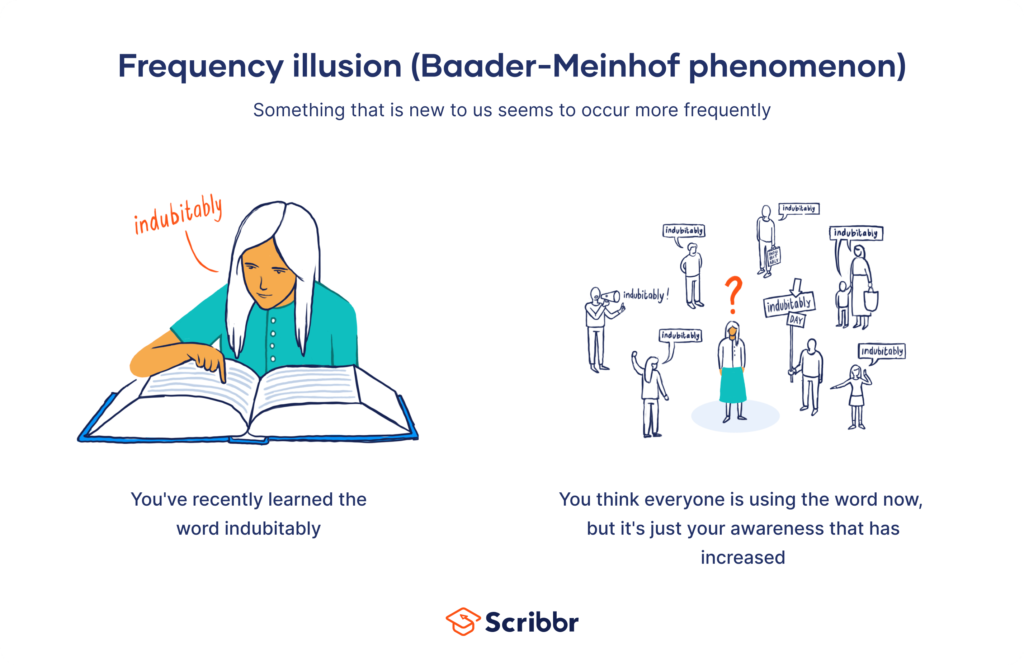If any of my family members or close friends are making Anzac biscuits, they always make it a point to call me. Why? Because the first time I made it for my daughter’s birthday, I made quite the impression (so they say).
I was quite the sensation on Facebook after one of my friends posted about it and everyone poured in with lovely comments (It was certainly gratifying to be recognised for something that’s not part of my job!).
I remember visiting the Coles close to home the next day, and noticed that all kinds of baked cookies were on sale. I also noticed that there were plenty of pre-made cookie mixes on offer.
To top that off, I was quite amused when I noticed advertisements on TV that had anything to do with baked goods. I felt like the universe was sending me not-so-subtle hints.
Well, according to psychologists, this is the Baader-Meinhof phenomenon at play.
It’s not that there are more baked goods in the world since I received compliments about my baking; but that I noticed products and advertisements that had to do with these more.
The Baader-Meinhof phenomenon is also known as the ‘frequency illusion’, and it’s a cognitive bias that explains how a name, word or thing that has come to our attention recently appears with improbable frequency shortly afterwards. That is to say, you see it everywhere.
Logically, that thing always existed, but you were unaware of it until that moment. Let’s unpack what this means for marketing.
The Baader-Meinhof phenomenon works subconsciously
The Baader-Meinhof phenomenon occurs when the brain is exposed to a new piece of information and begins noticing it everywhere. Also called the recency bias, there are two reasons why this phenomenon works the way it does.
The first is selective attention, which means your brain is subconsciously seeking out more information on the subject.
The second is confirmation bias, which means every time you see something related to the subject, your brain tells you that it’s proof the subject has gained popularity overnight.

This phenomenon demonstrates the importance of nurturing
Why: If you’re a marketer, I’m sure you know how incredibly important it is to nurture your customers or audience. As a brand, your goal should be to be the first thing that pops into your customer’s mind when they’re presented with something related to what you do.
Ever hear someone say, “You’re the first person that came to mind” when they were thinking about something? If you can position your brand at that level within your industry, how convenient would that be?
With the help of psychological phenomenons like Baader-Meinhof, this becomes an easier task. All you have to do is nurture your audience.
How: Focus your marketing efforts on letting potential customers know you exist through content that sparks interest and makes them question how they ever survived without your product or service.
Then, nurture them through tactics like targeted emails, retargeting ad campaigns, and ad boosts on social media.
The trick is to get into their heads so they notice you; you can let the Baader-Meinhof phenomenon do the rest.
The Baader-Meinhof phenomenon and confirmation bias go hand-in-hand
Why: Like I mentioned earlier, the Baader-Meinhof phenomenon works for two reasons—selective attention and confirmation bias.
Confirmation bias is a tactic that can be used to convince customers to buy from your company over your competitors. Essentially, confirmation bias means someone looks for evidence to confirm what they already believe, even when that evidence is neutral.
Once you’ve opened the door to a thought, it’s much easier to open it over and over again. Why confirmation bias works well with the Baader-Meinhof phenomenon is because it reinforces the suspicions that are already in your mind.
How: Always portray your brand in a positive light. I talked about how negative priming can affect all your marketing efforts in a recent post and discussed why a positive brand image is important.
Once the idea of your brand is in their minds, use advertising to reaffirm their beliefs about you. Make your unique selling point(s) memorable. Even if it’s something that everyone else is doing, if you’re the first to be explicit about it, people will associate it with your brand.
Brands use the Baader-Meinhof effect to dominate markets
In 2012, Red Bull made its way into sports fame when it sponsored Felix Baumgartner’s ‘Stratos mission’ where the sound barrier was shattered by the Austrian daredevil in a heart-stopping freefall. Today, Red Bull is the king of extreme sports—thanks to the Baader-Meinhof effect.
Here, I’ve given some more examples of big brands that are using the phenomenon to drive their marketing results.
Amazon
Every time I browse Amazon, different products keep popping up as I scroll. It’s something that I’m sure you’ve all experienced.
It’s this power of frequency that Amazon says is the secret to its success. The more you see something, it becomes more and more difficult to ignore. It creates a sense of trust which eventually results in a sale; this is the end goal of the Baader-Meinhof effect.
Prime
Prime went from $0 to $250 million in retail sales in its debut year and today it’s made its founders Logan Paul and KSI worth $8 billion. Taking inspiration from the Baader-Meinhof phenomenon, their strategy was simple. They wanted to be everywhere.
They flooded the market with their energy drinks and created a buzz that broke sales records. And if you’re familiar with how difficult it is to break into the beverage market, then you can imagine the impressiveness of this feat.
Disney
If you’ve got kids, Disney must be a big part of your life as a parent. With Mickey Mouse debuting in 1928, the team at Disney made sure that this cherished character was everywhere.
They did this because it’s all about connecting with your consumers. Every time you see Mickey, you instantly make the connection to Disney. It’s brand association done seamlessly and impactfully.
Make the Baader-Meinhof effect a part of your strategy
Repeat
Every day we’re exposed to thousands of pieces of information but we can only focus on a few.
Research shows that the more a person is exposed to a product, the more likely they are to go out and buy it. That’s why you need to expose your audience to your brand consistently using different channels.
Be creative
Saying something frequently has a way of making what you say more effective. But this doesn’t mean that you need to say the same thing over and over.
As a digital marketer, I know the importance of getting creative and finding new ways to get your brand message across to your audience could make all the difference between success and failure.
Be everywhere
Once you’ve got your audience to pay attention, you can start spreading your message across different platforms.
It’s about finding your customers, creating content they’re looking for, and also thinking about what works best to grab their attention and hold it.
The Baader-Meinhof gang
We’ve covered a lot of ground about this phenomenon and its influence on marketing. But before I wrap things up, I want to discuss the phenomenon itself and how it all began.
Over the years, the phenomenon has sparked a lot of interest and has also led to many wondering how this theory got its unique and difficult-to-pronounce name, myself included. It started with the Baader-Meinhof Gang which was also known as the Red Army Faction which was a terrorist group in West Germany that was active in the 1970s.
If you’re wondering how the name of a German terrorist group inspired the name that’s now attached to the concept of frequency illusion, the answer is a fairly simple one—it was born from the phenomenon itself.
It goes back to a discussion board in the 1990s when someone started asking about the Baader-Meinhof gang and then true to the phenomenon itself, started hearing the name mentioned several times within a short period.
Having failed to find a proper name for it, the concept simply became known as the Baader-Meinhof phenomenon. And if you were also wondering how to pronounce it, it’s ‘bah-der-myn-hof’.
Clarity and positivity are critical to leveraging the Baader-Meinhof phenomenon successfully
This frequency illusion occurs on its own, but without a strong marketing foundation, you can’t reap the benefits of this psychological phenomenon.
When you’re working on your content to reach your audience, make sure you formulate a clear and positive brand message with clear benefits.
This means that you need to make a genuine effort if you want to see this phenomenon at play. Strive to be the Nike of athleisure or the Ben and Jerry of ice creams. Leave your brand on top when consumers are making purchase decisions.
I’m not going to change careers and become a home baker, but it has been great being exposed to this world of baking 🙂


